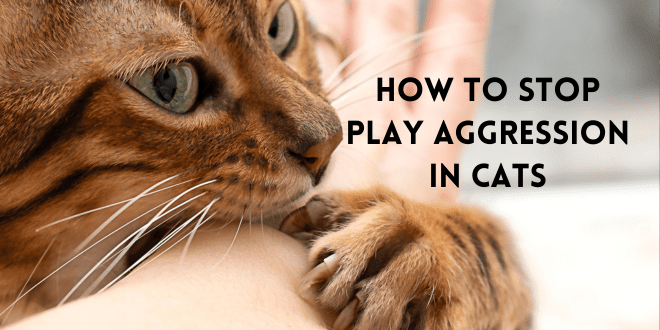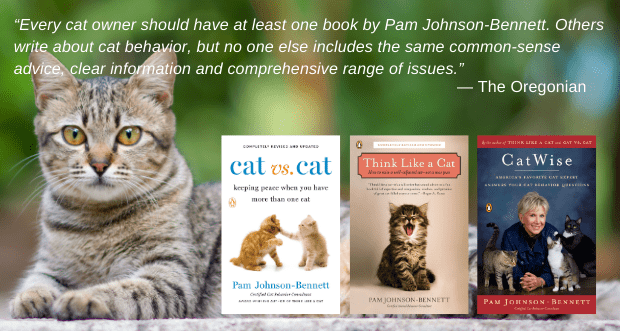
What is Play Aggression?
This is when playful bites, scratches, and ambushes become more serious and can actually cause injury. It’s something cat parents tend to notice more when the aggression is directed toward them, usually in the form of ankle attacks, ambushes, or biting and scratching that break the skin.
This type of aggression is usually seen in kittens and young cats. As most everyone knows, cats are hunters and that instinct kicks in at a very young age as kittens play by stalking, chasing, and pouncing each other. Although rough play and miscommunication may happen as kittens play with each other, this is an important time of learning. This time spent together helps them develop healthy play skills as they take turns being the mock aggressor and learn to control the intensity of biting, scratching, and wrestling. During play with littermates, kittens learn to keep their claws sheathed and not inflict injury. Kitten play also teaches necessary skills needed for survival and hunting as adult cats.
Kittens who had the benefit of being raised around littermates, learn these valuable lessons in order to keep the activity well within friendly play mode. Kittens who are orphaned or taken away from their littermates too early, miss important social lessons and may then develop play habits that include more aggressive biting and scratching.
Kittens who don’t receive adequate socialization, are played with improperly and roughly by humans, or not given appropriate objects or opportunities for play may also develop play aggression behavior. These cats may be less inclined to keep claws sheathed or control biting intensity.
Play aggression is one of the most common forms of aggression displayed toward human family members. Cats will engage in the postures associated with hunting such as stalking, ambushing, biting, and scratching, with the target being the human’s moving feet or hands.
Playtime Early in Life is Important
Playtime is important throughout a cat’s life, but for kittens, it’s a time they’re learning about their skills and developing balance, speed, accuracy, and coordination. Playtime can involve solo play, where the cat focuses on toys such as the fake furry mice strewn across the floor or the open paper bag just waiting to be pounced on. There’s also social play, where the cat engages with another companion cat, other animal, or a human. When a kitten bites a littermate too hard during playtime, that kitty’s reaction lets him know he crossed the line. This important time together for playtime lessons is just one of the many reasons kittens shouldn’t be taken away from the mother cat and littermates too early.
Rule Out Other Forms of Aggression
A cat can exhibit aggressive behavior for other reasons. Before you decide that the behavior is play aggression, it’s important to rule out other potential causes such as fear, pain, illness, redirected, petting-induced, and so on. Pay attention to the circumstances leading up to the aggression to help identify the type. Make sure you have your cat checked by the veterinarian in order to determine if the aggression is the result of pain, injury, or illness. With play aggression, you typically won’t hear any hissing or growling, and although the bites or scratches hurt, the cat’s face won’t look as if he’s fighting for his life. As mentioned before, play aggression tends to occur more often with singleton kittens, young cats, or ones played with too roughly by humans.
Let’s Start With What Not to Do
- Never use your hands as toys. Wiggling fingers may seem like a very innocent and convenient way to entice a kitten to play but it’s a dangerous precedent to set. This method teaches the cat that biting flesh is acceptable. Even if the bites and scratches don’t hurt you now, they may as the kitten grows. You also don’t want your cat engaging in that type of play behavior with your young child or elderly relative where injury could almost certainly occur. Training messages should always be consistent throughout the cat’s life so never use your hands, feet, or any other body part to serve as a cat toy. If you don’t want your cat to bite you when he’s upset, then don’t teach him that biting a human during playtime is an ok thing to do. Be consistent in your messaging.
- Don’t pull away. If your cat has grasped your hand with his teeth and won’t let go, don’t pull away from him because that’s what prey does. Pulling away will trigger the cat to bite down even more. Instead, gently push toward the cat to momentarily create confusion and this will cause him to loosen his hold. When he does let go, either stop all play motion and ignore the cat for a few moments or move away from him completely. The lesson you want to get across is that biting or scratching you will result in an immediate end to the game.
- Don’t punish. Don’t physically punish, hit, scruff, push, or toss your cat away from you for displaying play aggression. Physical punishment often just raises a cat’s reactivity and it’s possible that the play aggression will cross over into more serious aggression. Physical punishment can also cause a cat to become afraid of you and teach him to be more defensive.
- Don’t wrestle with your cat. You’re much bigger than him and can easily end up being viewed as an opponent. Wrestling with your cat will often turn his behavior defensive. Hands are for loving touch, not for pinning a cat on the floor.
- Keep the gloves off. And speaking of hands, don’t get fooled into buying those goofy gloves that have toys tangling from the fingers. A hand is still a hand, even if it’s surrounded by a glove.
How to Stop Play Aggression Behavior Toward Humans
- Have appropriate toys for solo playtime. Encourage healthy solo playtime by having a variety of safe toys to leave around the house. You may have to experiment with some to determine if your cat has specific preferences but in general, cats like furry mice, lightweight balls, and other objects that can be easily batted around. Strategically place toys to encourage your cat’s enticement. Place a furry mouse on the end of a cat tree perch or have it peeking out of an open paper bag on the floor. Don’t just leave a pile of toys in a basket where they’ll gather dust. Additionally, don’t hold these small toys with your fingers in order to play with your cat. It can be too easy for an excited cat to mistake your finger for the toy and end up causing injury. These small toys are strictly for solo play.
- Have appropriate toys for interactive playtime. The safest and most effective way for you to play with your cat is by using a wand-type toy. This puts a safe distance between your fingers and the cat’s teeth or claws. The wand toy, based on a fishing pole design (wand, string, toy on the end), also allows you to control the movements to optimize your cat’s enjoyment of the game. You can maneuver the toy to go behind something to momentarily hide, have the toy wave in the air, dart inside an open bag or box, and make impossible-to-resist movements that resemble prey. An interactive toy allows the cat to stalk, ambush, bite, scratch and best of all, have a successful capture. In his enthusiasm, he also never has to worry about accidentally biting your fingers or causing injury. Interactive playtime should be done at least twice a day for about 15 minutes each but if you can squeeze in more playtime, that’s even better. What’s most important is that you establish a routine schedule so your cat benefits from daily enrichment, stimulation, success and FUN! Interactive playtime is also a great way to re-establish the bond between you both. If you’ve been dealing with play aggression then that bond probably does need a little repair.
- Provide more overall environmental enrichment. Part of the reason your cat may be engaging in play aggression might be due to a boring environment. While it’s much safer for cats to be kept indoors, the problem is it can be easy for them to get bored when cat parents haven’t created opportunities for discovery and stimulation. Provide a cat tree and window perches so your cat can look at the birds outdoors. If you have a multicat household, the more elevated areas you provide, the better. When you increase vertical territory it can help maintain peace and it will appear to the cats as if their territory has increased. Vertical territory also creates opportunities for climbing, jumping, and playing.
- Spruce up the place. In addition to vertical territory, tweak the environment by adding tunnels for hiding, napping, and playing. Cats love to check out enclosures and a soft-sided cat tunnel or even some open paper bags and boxes will enable your kitty to go exploring.
- Food enrichment. Satisfy some of your cat’s playtime desire by using puzzle feeders. Food enrichment toys provide a little bonus playtime with a food reward for a job well done. This is a totally natural concept for a hunter. If your cat eats too quickly, puzzle feeders can also encourage a healthier eating pace. You can make homemade puzzle feeders or you can purchase them. Some are made for dry food and some for wet. A quick online search will provide you with many options for puzzle feeders so you can find the types that will work best for your cat.
- Timing is important. Pay attention to the times your cat seems the most active or restless and schedule your interactive play sessions for those times. If you’re only able to do two play sessions a day, my recommendation is to do one session in the morning before you leave the house for work and then a session in the evening. If your cat bothers you during the wee hours of the morning, schedule your evening play session for right before you go to bed and then offer him a meal.
- Encourage success and satisfaction. Whenever you engage in an interactive play session, whether it’s for a couple of minutes or a half-hour, make sure the cat has several successful captures. At the end of the game, wind the action down to help settle the cat and help him feel as if he has captured his prey. Don’t just abruptly end the game or else you may find that you’ve left the cat still revved up.
- Be prepared. If your cat tends to attack your ankles when you walk, or hides behind objects in order to ambush you, carry some small toys in your pocket so you can toss them away from you to redirect him toward acceptable play objects.
- Feline Friend. If you think your cat may be lonely, especially if you work long hours away from home or even travel quite a bit, consider adopting another cat. Many people mistakenly associate cats as being solitary but they’re really social creatures. Just make sure you take the time to do a gradual, positive introduction to address a cat’s territorial nature.
How to Control Play Aggression Directed at Another Cat
- Safe zones. Make sure the environment is set up so each cat has a safe place to retreat. Cat trees, elevated cat walkways, perches and tunnels add to the feeling of safety. In some cases the cats may need to be totally separated and reintroduced if one cat is playing too aggressively and the victim cat seems completely fearful of any form of interaction.
- Play therapy. Conduct individual interactive play sessions with each cat to help build confidence and release stress. This also teaches each cat the correct way to play. Set up a consistent schedule so playtime occurs at least twice a day.
- Group play. If you want to conduct a play session with both cats at the same time, don’t use one toy or else it can lead to intimidation. Hold an interactive toy in each hand so no one has to compete for the prize. If there’s another family member available to help with the game then that would make it even easier to do a group play session.
- Proper new cat introduction. When introducing an additional cat into the household, take the time to do a proper introduction by placing the new kitty in a sanctuary room. Gradually introduce the cats to each other through positive associations. Don’t just put the cats together and expect them to work it out.
- Use redirection. When cats are playing together and you suspect things are starting to get out of hand, distract them with something positive such as tossing a little toy nearby or rolling a ping pong ball across the floor.
- Food enrichment on the menu. Puzzle feeders are a wonderful way to distract cats from each other. When you have more than one cat, just make sure you have set up several puzzle feeders so there’s more than enough for everyone.
- Is it just rough play? Keep in mind that sometimes what appears to be fighting between cats may actually just be normal play. An aggressive display usually involves vocalizations such as growling or hissing and facial expressions will look aggressive with ears flattened back. We sometimes make the mistake of labeling normal rough play as aggression. If you’re in doubt, don’t yell at the cats to separate them but instead, toss a toy or two as a fun distraction.
Need More Information?
For more specifics about cat behavior or to learn step-by-step techniques for interactive playtime or new cat introductions, refer to the best-selling books by Pam Johnson-Bennett. Pam’s books are available at book stores and online. We’ve also included Amazon links here on our website.
If you have a question about your cat’s behavior or health, contact your veterinarian. This article is not intended as a medical diagnosis nor is it a replacement for your cat’s regular veterinary care. This article is for general information purposes only.





